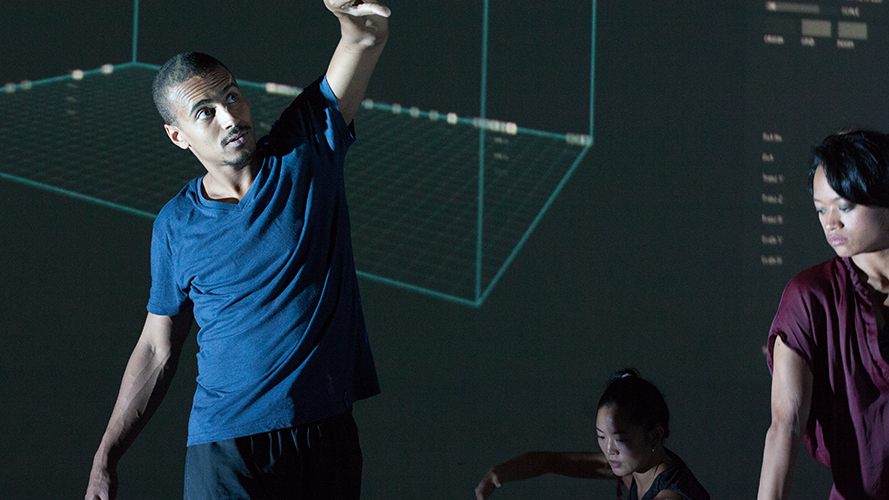
PATHFINDER
The project PATHFINDER aims to contribute to the creative processes of choreographic development, instead of serving as data management and abstraction. The artwork is a generative approach for conceptual choreographic research of body movements. Therefore, algorithms generate graphical patterns to stimulate a dancer’s creativity and open up new perspectives. With the inspirational impetus coming from a machine, PATHFINDER opens up a space where abstract cycles of dance can be introduced without notions of style or specification.
PATHFINDER is an experimental tool which aims to create visual inspirations instead of recreations, and therefore becomes its own creative building block, questioning the classical master slave paradigm. In order to define a desired type of animation, the choreographer is able to adjust certain parameters of the algorithm, such as speed, complexity, or geometric objects. PATHFINDER generates different shapes morphing into each other in a logically and sequential manner. The dancer is able to see this output and react in a preferably spontaneous way in order to provoke uncertain results and surprises. However, he is not able to define the precise visual output. Such a limitation was implemented to ensure the algorithm’s own contribution to the process. In order to do so, a visual language was developed, consisting of a set of reduced graphical primitives which are progressively transforming. In this view, Pathfinder becomes a generative concept itself in several aspects.

In order to create a communicative pattern between dancer and graphics, PATHFINDER shows a visual language which allows for interpretation whilst being neither too graphic nor too abstract. Hence the main target was to find a visual balance between abstraction and ascertainment.Thinking of dance as a process of human shapes continuously transforming from one state to another, PATHFINDER is narrowed down to shapes and transformations: using the visual language of Kandinsky’s Point to Line to Plane. In the book, Kandinsky analyzes geometric primitives and their effect on the observer. Making use of his theories and restricting such shapes to geometric primitives. Instead of showing just point, line and plane, PATHFINDER shows the transition from point to line to plane. Also, a dancer’s actions to transform his body from one shape to another are called transitions. Pathfinder investigates how this process can be applied to graphical programming and an algorithm which is able to generate logical transitions between all kinds of different geometric shapes can be developed. In order to generate this algorithm, every object was broken down into its polygons. The algorithm then calculates the most logical sequence of transformations from one object to another, including the transformations of all of its individual polygons. The abundance of this graphic as a formative theory is becoming a design language that can scale endlessly.

Generative solutions within the fields of art have a long history. Especially within music and visual arts, the usage of computational solutions enabled new perspectives and raised new questions towards artistic productions, ownership and expression. However, narrowing down the possibilities of modern algorithms to measurement and translation does not reflect the contemporary role of algorithms within the field of artistic research and generative design. The project PATHFINDER enabled an exploration of new possibilities as well as mechanisms to use generated graphical content as a creative impulse. PATHFINDER allows dancers to break with artistic habits: While improvising movements, many dancers have the tendency to get caught up in repeating loops, trained concepts, or simply habits. The generative language PATHFINDER inspired them to be stimulated and inspired freely in dancing.

This system is developed in collaboration with Onformative, a studio for generative design. Raphael Hillebrand helped with choreographic consultancy and scientific insight into the field of contemporary dance. His work combines urban dance and contemporary dance and has contributed in multiple ways. The PATHFINDER Project was finalized and presented at Choreographic Coding. Choreographic Coding is a laboratory invented in 2013, as part of the Motionbank research project of the Forsythe Company.

